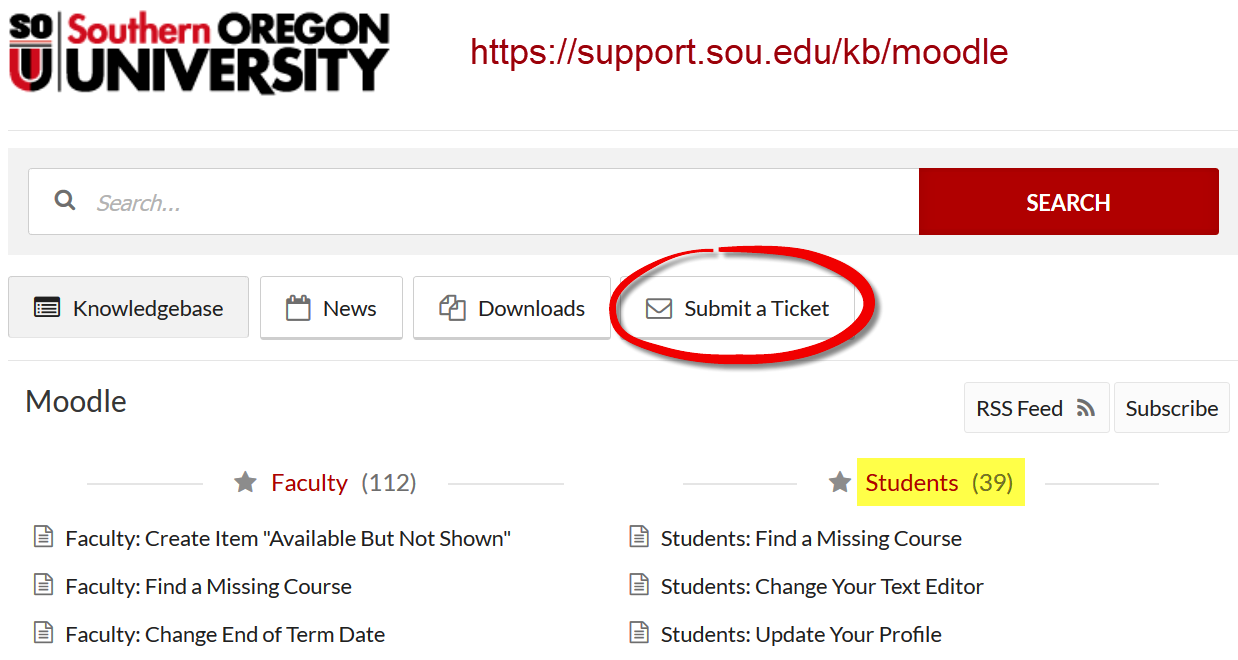Student Guide to Moodle
| Site: | Southern Oregon University |
| Course: | Southern Oregon University |
| Book: | Student Guide to Moodle |
| Printed by: | |
| Date: | Saturday, December 13, 2025, 1:07 AM |
Description
Updated and expanded guide to everything Moodle at SOU!
Table of contents
- Welcome to Moodle!
- Browser Requirements
- Logging In
- Accessing Your Courses
- Navigating Your Course
- Course Icons
- Updating Your Profile
- Participating in Discussions
- Working in Groups
- Working with Assignments
- Basic Software Requirements
- Taking Tests
- Checking Your Grades
- Using Checklists
- Using the Calendar
- Messages in Moodle
- Finding SOU Services
- 🆘 Getting Help 🆘
Welcome to Moodle!
 If you're new to Moodle, this guide will provide information about getting started and using many of the common tools and features used at SOU.
If you're new to Moodle, this guide will provide information about getting started and using many of the common tools and features used at SOU.
To navigate through this guide, click on a chapter name in the table of contents on the right or use the arrows in the upper and lower right corner of each page. (Expand the blocks panel on the right to display the table of contents for this book. If you don't see the table of contents on the right, you'll find it below the content of each page.)
After reviewing this book, spend a few minutes in the Test Drive course—go ahead, self-enroll then kick the tires and slam the doors! Once you're enrolled, you'll find the course listed at the bottom of your SOU Moodle home page under "My courses" or in the navigation panel on the left. Enjoy!
Browser Requirements
 We recommend using a recent version of Firefox or Chrome. While Safari may be fine for viewing Moodle resources, we don't recommend using it for submitting assignments or taking tests in Moodle. Internet Explorer will NOT work for our current version of Moodle.
We recommend using a recent version of Firefox or Chrome. While Safari may be fine for viewing Moodle resources, we don't recommend using it for submitting assignments or taking tests in Moodle. Internet Explorer will NOT work for our current version of Moodle.
We also recommend a high speed Internet connection for best performance.
Pay attention as you download any software to ensure that you are not installing applications that you don't want at the same time. You are not required to agree to add other features to use the browser.
Logging In
You can log into Moodle from Inside SOU or by going directly to the Moodle log-in page. If the Moodle link in Inside SOU does not work, use the instructions for going directly to the Moodle site to access your Moodle courses.
- Logging in through Inside SOU: Log in to Inside SOU and click on the Moodle link at the top of the page. (There's no need to log in again.)

- Going directly to the Moodle site: Go directly to Moodle at https://moodle.sou.edu. Click on SOU Account Login. Enter your SOU ID number (940-------) in the Username field. Enter your SOU network password in the Password field. Click on the Login button.
Get the Moodle Mobile App!
You're on the move and so is Moodle. Download the app today.
Help for Logging In
For assistance with logging in, contact the SOU Help Desk at 541.552.6900 or helpdesk@sou.edu.
Accessing Your Courses
Be sure you are logged into Moodle before attempting to access your courses. There are four ways to access your courses:
- My courses list. Expand the blocks drawer on the right side of your landing page and open the term category to access courses available to you in a given term.
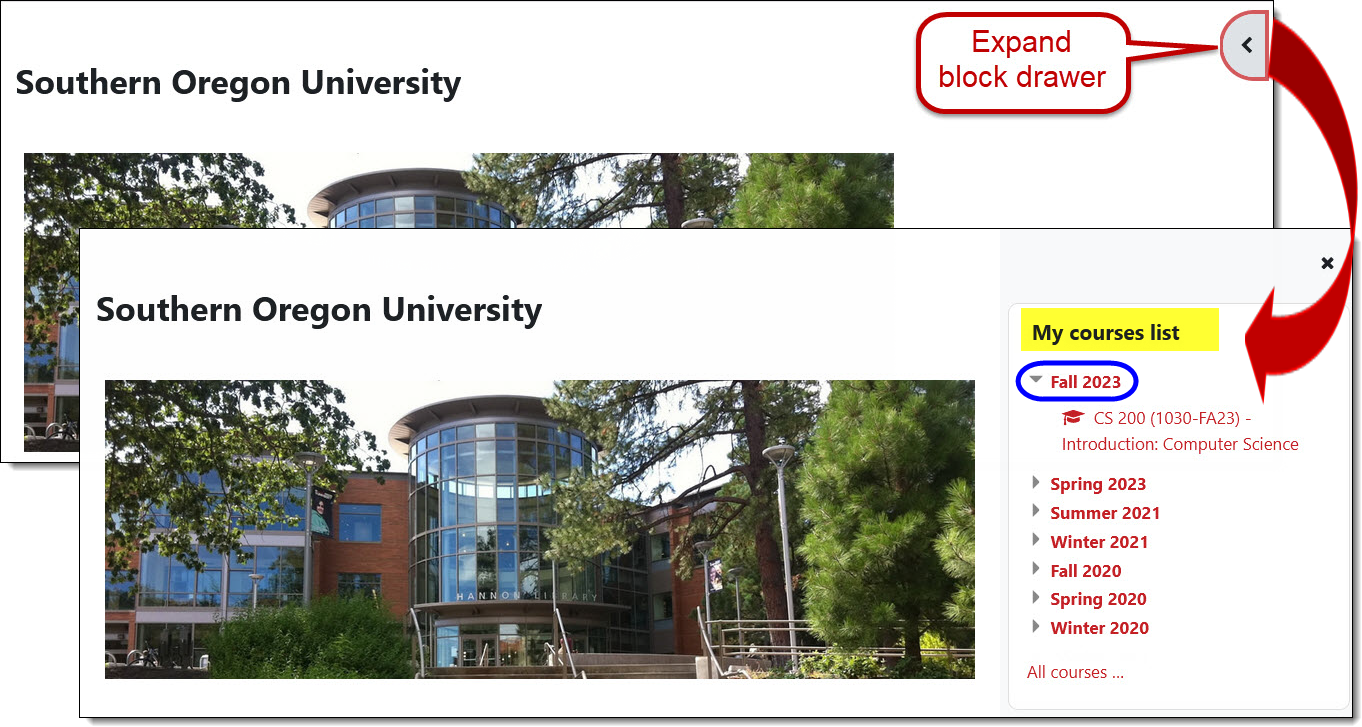
- Dashboard: Click on the link in the red border at the top of the page. Your dashboard will include a section for courses that you have recently accessed, links to activities that you last opened, and any courses that you have starred for quick access. Learn more about your dashboard.
- My courses: Click on the link in the red border at the top of the page. All of the courses that you are enrolled in will be shown on the page. Use the filter options at the top of the page to locate past courses.
- My courses: This list is located in the center column of your Moodle landing page under announcements and links to Moodle guides. Courses for the current term are listed first, followed by any courses from prior terms that are still available to you. (You cannot hide any courses in this list. The only way to remove a course from the list is to ask the instructor to make it unavailable.)
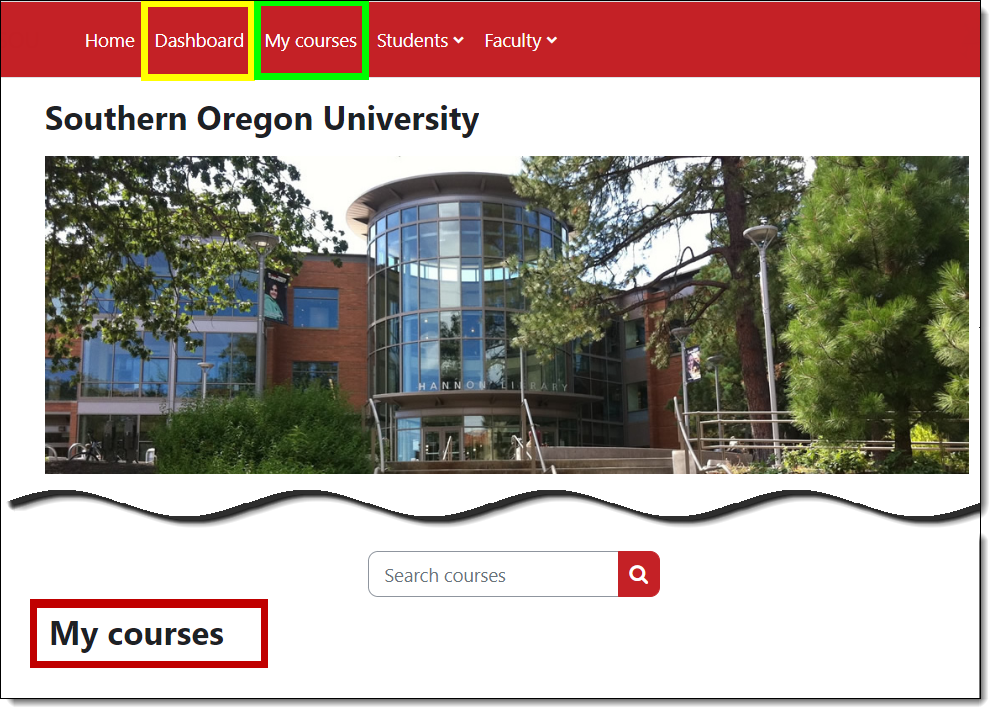
Dashboard Overview
Here's a quick overview of what's in your dashboard. Learn more, including how to customize your dashboard.
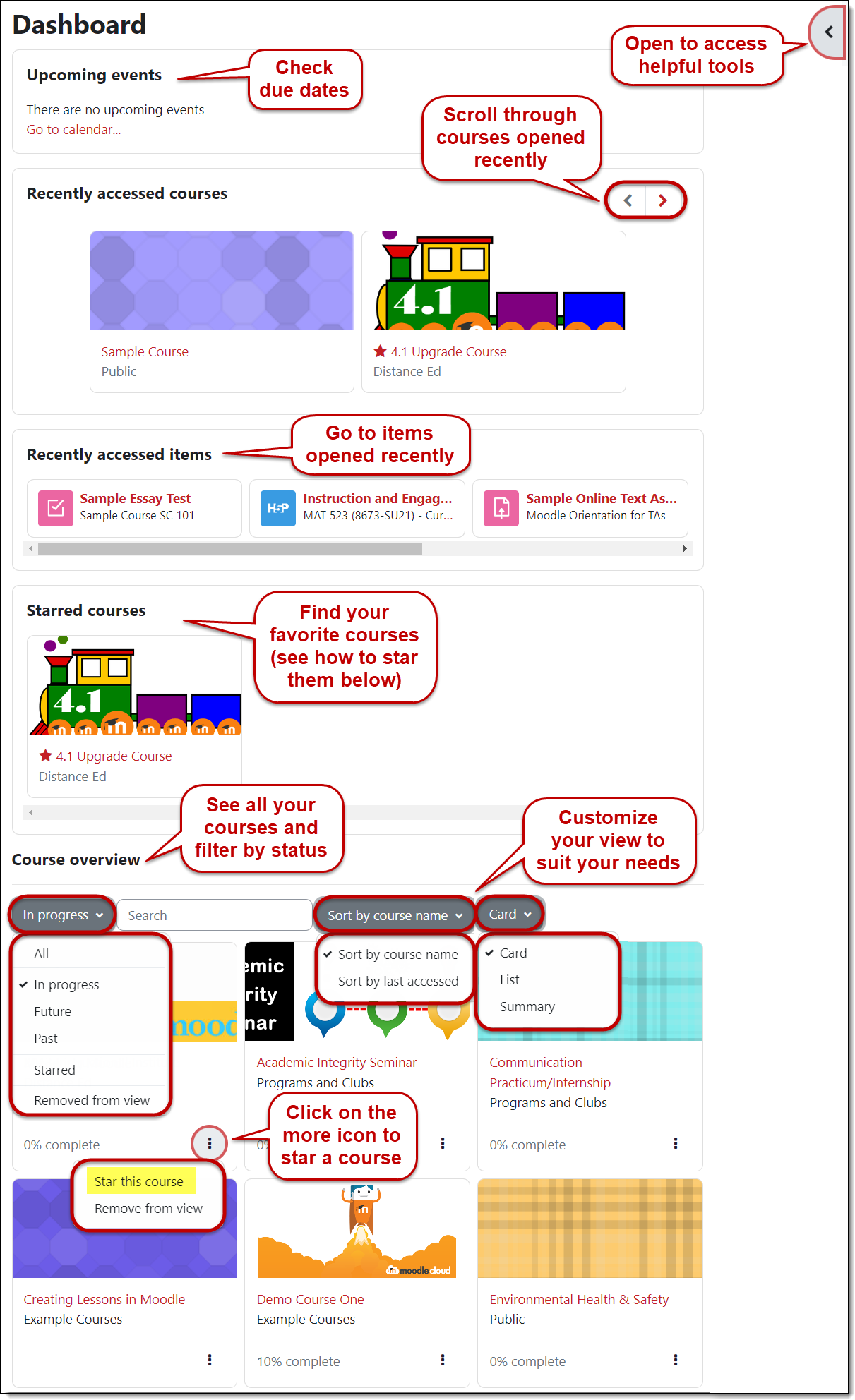
Dashboard Calendar
Your dashboard also includes a calendar which displays activity due dates and events for all of your courses. Clicking on an entry displays more information and a link to go to the activity itself. You can add personal notes by clicking on the New event button.
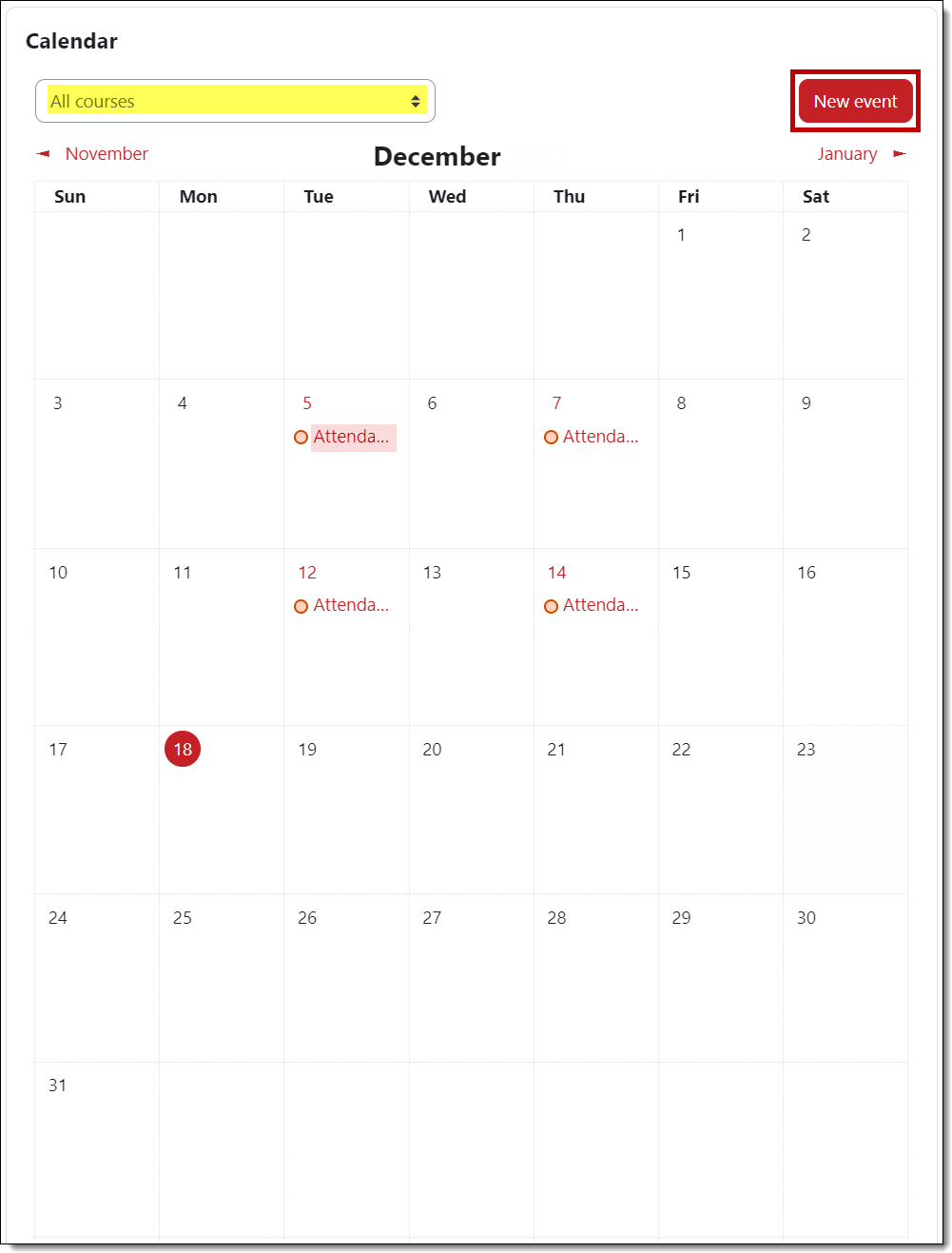
Courses Not Yet Started
Courses are made available to students by instructors, so availability will vary from course to course and term to term. Courses for a new term may be available to you as early as one week before the term start date or may not be available until after your class meets for the first time.
Courses available prior to the new term start date will be listed on your Moodle landing page under My courses, in your Dashboard under All or In progress, and in the My courses link in the top red border. If you don't find a course link, keep in mind that some instructors don't make their courses available until after the start of the term, and others do not use Moodle at all.
If you don't see your course for the new term, see these instructions.
What to Do If Courses Are Missing

Availability More Than One Week Prior to a New Term
If an instructor notifies you that your course is available more than a week prior to the new term start date, you'll find the course listed on your Moodle landing page under My courses and in your dashboard under Future courses. You can filter courses as shown here to locate any course available to you more than a week prior to the term start date.

Availability in the Week Prior to a New Term
Courses Missing as the Term Begins
If you don't find a course, keep in mind that some instructors don't make their courses available until after the start of the term, and others do not use Moodle at all.
If a course for which you are registered does not appear in your list of courses AFTER the term starts, please take both of the following steps BEFORE contacting the Help Desk:
- Verify that you are registered for the course. Wait-listed courses will not be available to you in Moodle.
- Make sure that your instructor has made the course available.
To find out if the course is available, locate the Search courses field just above the list of My courses on your Moodle home page. Enter the CRN of your course in the search field and click on the search icon. If the CRN is displayed, check the course name and/or term "category" to see if it is the course you're looking for. If you don't find the CRN listed for the current term, your instructor has not yet made the course available to students. Contact your instructor to see if he or she intends to use Moodle.

If your instructor has made the course available to students and you are fully registered for it and you still don't see it in your list of courses, contact the Help Desk. Be ready to provide the following information:
- Your full name and SOU ID number.
- Course name and CRN.
Please note: If a course has been made available while you are already logged into Moodle, you will need to refresh your Moodle home page to see the course. (In most cases, you can refresh the page by clicking on the circular arrow on the browser address bar.)
Moodle on Your Mobile Device
 You're mobile and so is Moodle! Moodle mobile is free and available for iOS, Android, and Windows. See these instructions for downloading the Open-LMS Moodle mobile app.
You're mobile and so is Moodle! Moodle mobile is free and available for iOS, Android, and Windows. See these instructions for downloading the Open-LMS Moodle mobile app.
⚠️Be careful when you log in the first time to scroll down past the Raider Hawk to the SOU Account login fields.
Navigating Your Course
To open a course, click on its name. At the very top of the page, you'll find quick links to your dashboard and to a list of your courses as well as a pull-down menu with helpful links including Moodle How-to's for Students.
In the course information area in the top section of the page, you will likely see an Announcements link, the course syllabus and other materials posted by your instructor. The sections below will contain links for activities and resources that you will need to access throughout the term.
In the Course index on the left, you'll find links to all of the activities and resources in the course. Across the top of the page you'll find course links for accessing a course participant list and your grades. On the right side of the page (or at the bottom, depending on your screen view) you'll find course tools in the Blocks drawer or panel. Blocks include Activities, Quickmail and Calendar. The Activities block offers quick links to all of the activities and resources posted in your course. With the Quickmail block, you can send email to your instructor or classmates (all messages go to SOU email accounts). Your course may also include blocks for a course calendar, SOU Resources, upcoming events, recent announcements, etc. Both the Course index panel and the Blocks drawer can be collapsed by clicking on the X in the top corner.
A so-called "breadcrumb trail" appears just below the quick links near the top of the Moodle page. Each time you open a new page, a link to the previous page appears on this trail.
- Click on "Home" to return to your Moodle home page (where you land after you log in).
- Click on the course name to return to the course home page (where you land when you first open the course).
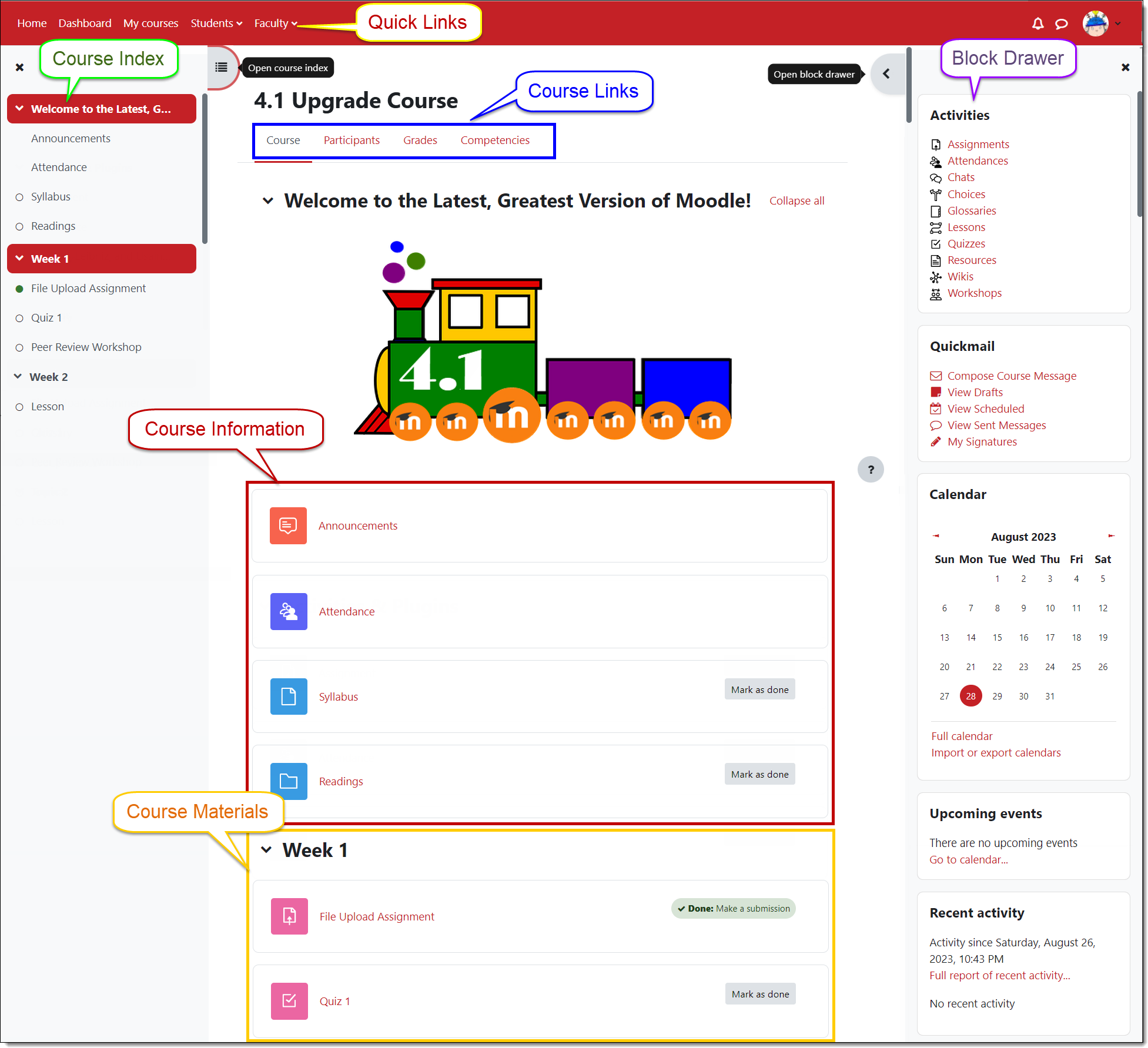
Course Icons
You'll find many different kinds of resources and activities in Moodle. Note that your instructors may post items so that you can check them off as you complete them (Mark as done), as shown in the example shown below. In other cases, you will need to view or post something before Moodle automatically checks it off. The action required will be spelled out on the course page as shown below.
Course elements are color-coded by general function:
- Blue for content (page, file, URL, book, folder, etc.)
- Green for collaboration (chat, choice, questionnaire, etc.)
- Pink for assessment (assignment, quiz, workshop, etc.)
- Red for communication (forum, glossary, wiki, etc.)
Here is a quick guide to some of the most common course elements.
Web Page. A web page will contain text and may also contain web links or embedded files to be used as resources.
Files. Many kinds of files may be linked in your course site.
Book. A book may contain all kinds of things: web links, text, embedded files, audio links, video links— you name it!
Folder. A folder contains files that you can open or download to your computer.
URL. Web links may be provided for your reference.
Forum. Discussion forums offer opportunities to reflect on your learning and share ideas with your classmates.
Assignment. Links for assignments may allow you to upload files or enter text. To see your score and feedback from your instructor, reopen a link after the assignment
has been graded. This guide to assignments has
more information.
Quiz. Moodle calls any kind of online test a "quiz." Tests, midterms, and final exams will all appear as quizzes in Moodle.
Choice. A choice is a polling feature that your instructor might use to find out what you think about a topic or to have you sign up for a project.
Glossary. You may have the opportunity to contribute to a glossary by adding a "concept" and "definition."
Wiki. A wiki is a space for collaborative writing.
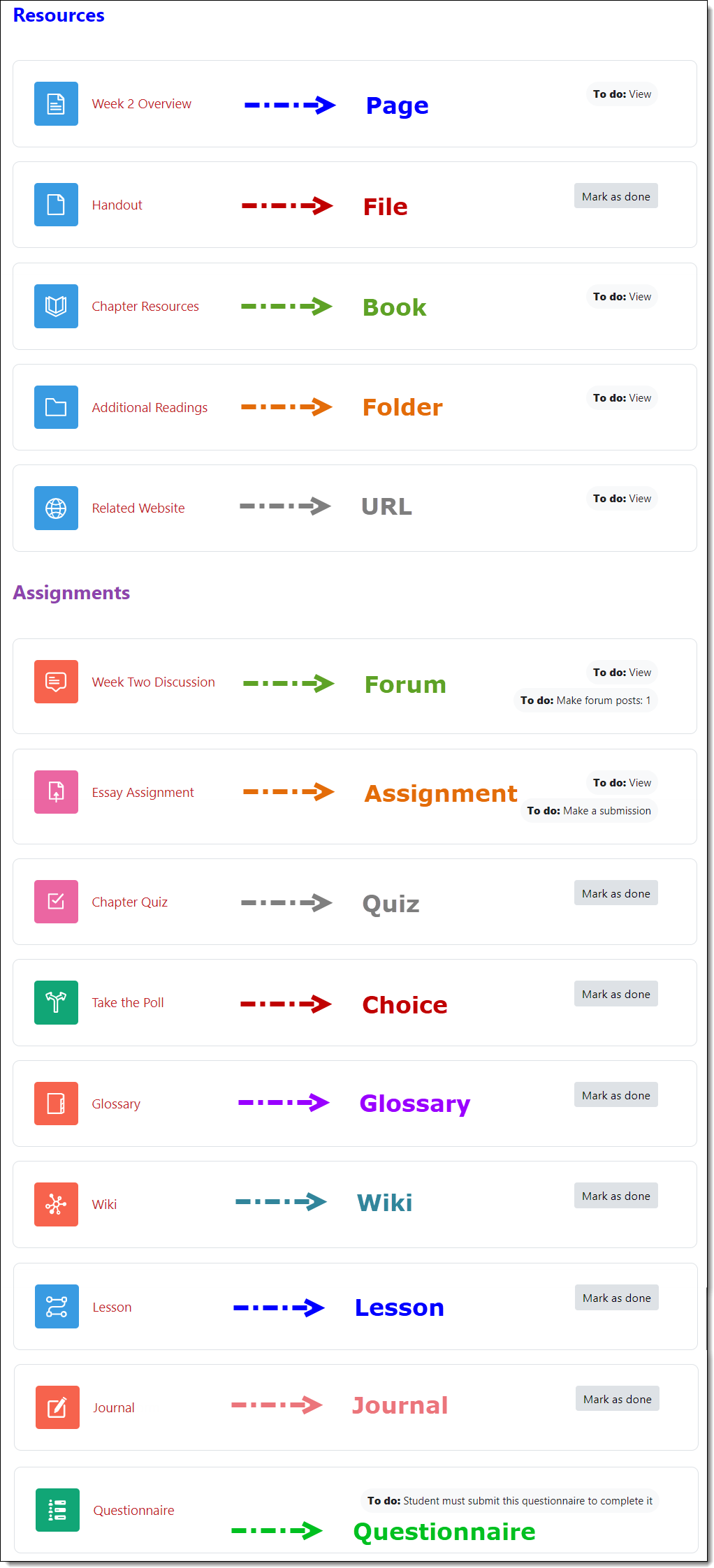
File Conversions
Moodle has a file conversion app that lets you request a different type of file than the one posted in your course. A pdf, for instance, can be converted to a variety of text file types, naturally, BUT it can also be converted to:
- an audio file (featuring natural phrasing and intonation—and you can choose the playback speed!),
- an e-reader file (with a choice of formats!), or
- a Braille file.
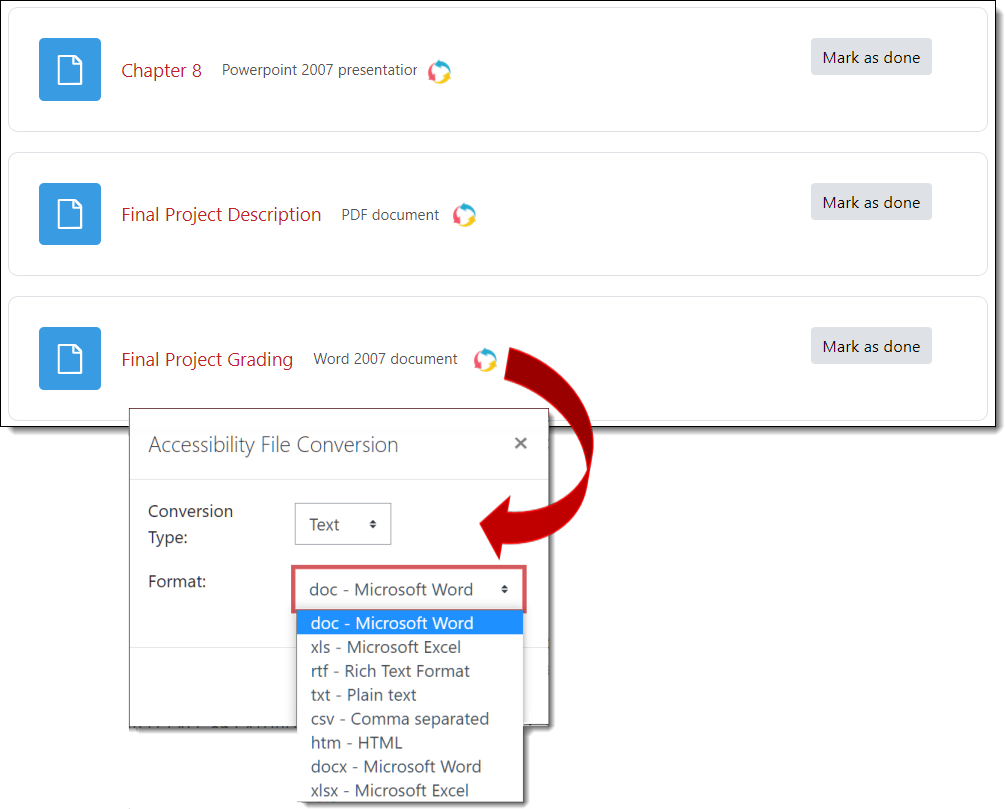
Updating Your Profile
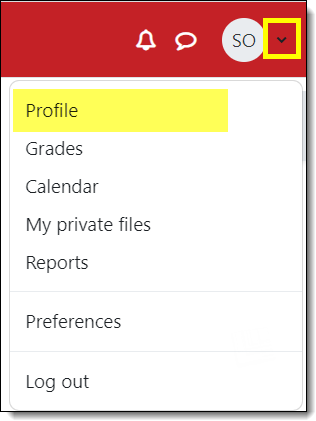 Profiles help to build a sense of community. Your Moodle profile will be accessible in any course in which you are enrolled, so you need only create it once and update it as needed. Updating your profile is easy to do!
Profiles help to build a sense of community. Your Moodle profile will be accessible in any course in which you are enrolled, so you need only create it once and update it as needed. Updating your profile is easy to do!
Editing Your Profile
To view or edit your profile:
- Click on the caret icon in the upper right corner to open the pull-down user menu.
- Choose Profile.
- Click on the Edit profile link in your dashboard.
- Fill in the city/town field and as many other fields as desired.
- Click on the Update profile button at the bottom of the page when you are finished.
How to edit specific fields in your profile is described in the following pages...
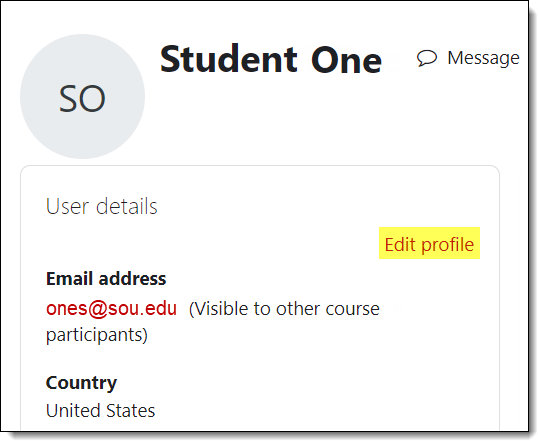
Personalize Your Profile
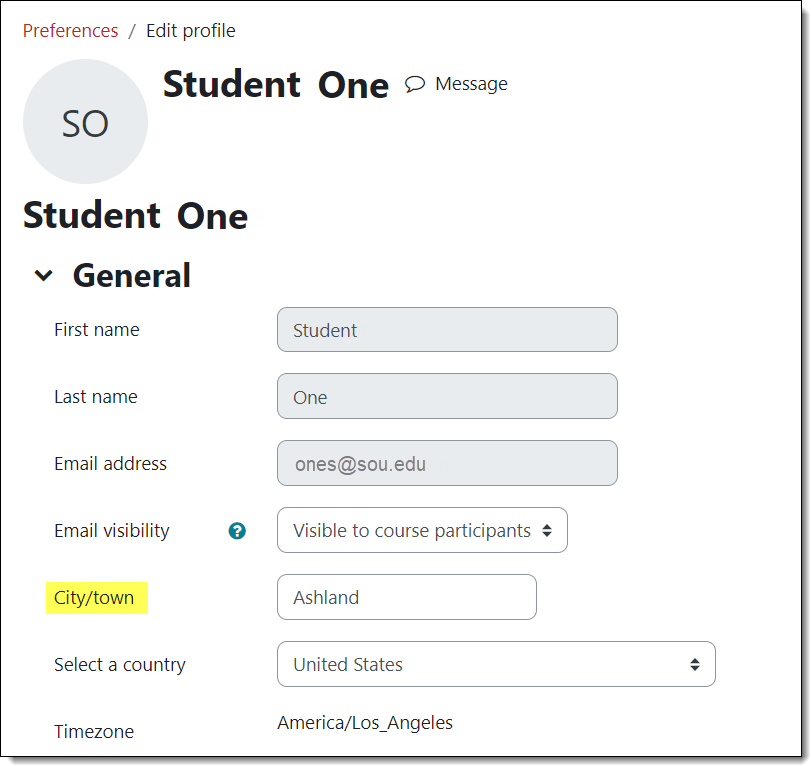
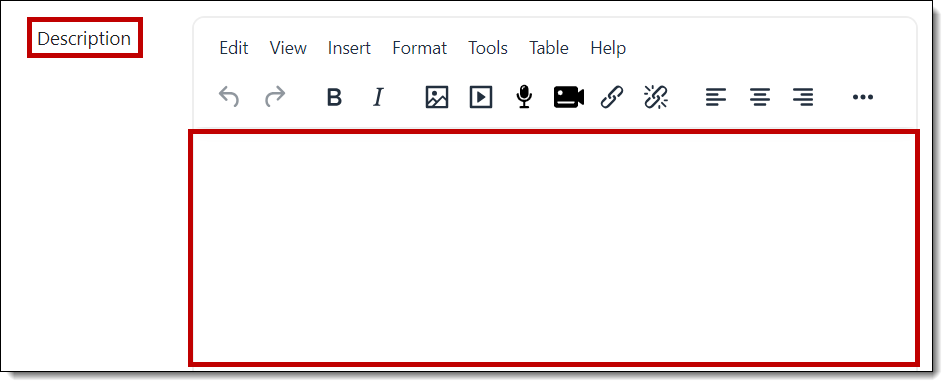
Add a Picture
You are encouraged to include a picture in your profile. Here are some things to know about this feature:
- A smaller version of your picture will appear next to your forum postings.
- Your picture must be saved in JPG or PNG format.
- Profile pictures are automatically cropped and resized to 100 x 100 pixels, so be sure to use a close-up of your face, not a full-length photo.
Upload your photo by dragging and dropping it into the file selection box or by clicking on the Files link at the top of the box. (Learn about Guide to resizing images.) Add a description of your picture for anyone using a screenreader or other adaptive technology to view your profile. If you wish to include pronouns with your profile, the Picture description field is one place to add them.
Note: To return to your Moodle home page after updating your profile, click on Home in the upper left corner of the screen.
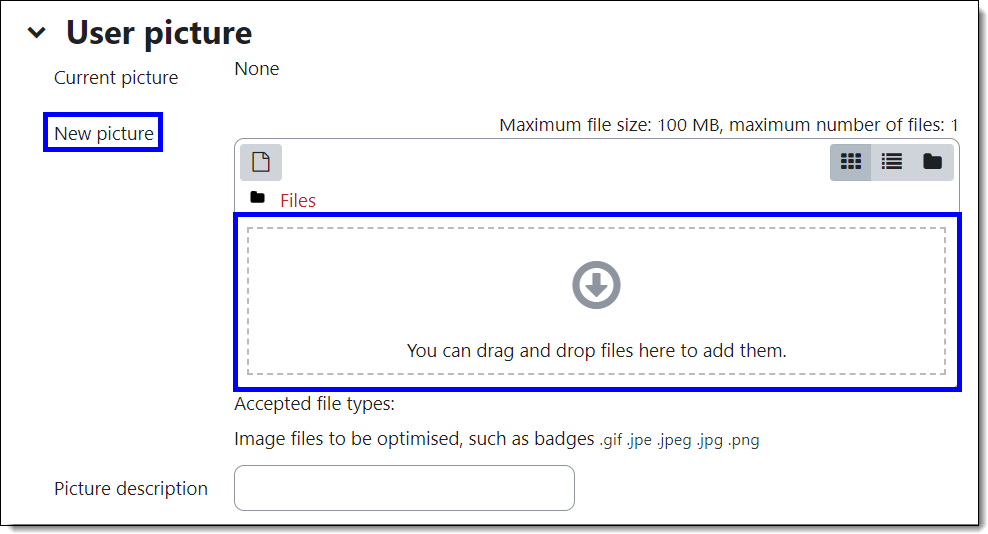
The additional fields in your profile will not be displayed to others, so they can safely be ignored.
Page down and click on Update profile to save your changes.
Change Your Name

You cannot change your name directly in Moodle. To use a different, preferred first name in Moodle and other SOU records, see this information page.
(While there is an "Additional Names" area in your profile, none of these fields is visible to any other users.)
Email Settings
![]()
Your Moodle profile is set for your SOU email address. All messages sent from Moodle will go to this address. If you prefer to use an alternate address for SOU email, you can set up your email to forward messages to that account.
Participating in Discussions
 Online forums allow you to reflect and share your thoughts about what you are learning. Messages remain posted in the forum for participants to read and respond to within a time frame set by your instructor or any time.
Online forums allow you to reflect and share your thoughts about what you are learning. Messages remain posted in the forum for participants to read and respond to within a time frame set by your instructor or any time.
Online discussions are usually considered to be homework, so be sure to review your writing prior to posting your thoughts. Follow your instructor's guidelines carefully to ensure that you receive proper credit for your postings. For example, you might be required to post to a forum at least once during the first half of the week, and then respond to another student's posting by the end of the week.
This handy handout explains how to participate in Moodle discussion forums. (See this accessible version in Word.)
Check out these helpful hints:
Helpful Hint #1: If you spend a lot of time composing a response, you might want to draft it in a Word document and then copy and paste what you've written into your forum message. If you craft a lengthy reply in Moodle itself, select all of the text in the message box and copy it before you attempt to post it, just in case your browser session has timed out without warning. If you need to, you can paste it into a new textbox—and avoid the frustration of having to start all over again! Read more about how to avoid losing text in textboxes.
Helpful Hint #2:You may be asked to attach a file to a discussion post in order to share your work with classmates. When you do, be sure your file name includes a file extension (.doc, .xls, .pdf, etc.) so that others will be able to open the file. Learn how to "embed" a web link in a post in case you'd like to provide a link to a website in your discussion thread.
Helpful Hint #3:You can insert photos in your posts, but be sure to make them a reasonable size (4" x 5" or 300 x 400 pixels, under 1MB) before you post them. Moodle displays photos in their "native" size – a full-screen photo of you and that steelhead might be a bit much for the rest of us! Find out Resize Photos for Moodle.
View Forum Feedback
The gradebook will show you a score for a forum, but if your instructor used a rubric to grade it, you won't see the individual scores that contributed to your total score and you'll miss any feedback that your instructor provided.
To review your individual scores and feedback, open the forum link and click on View grades. (See this article to learn more about viewing feedback in a rubric.)
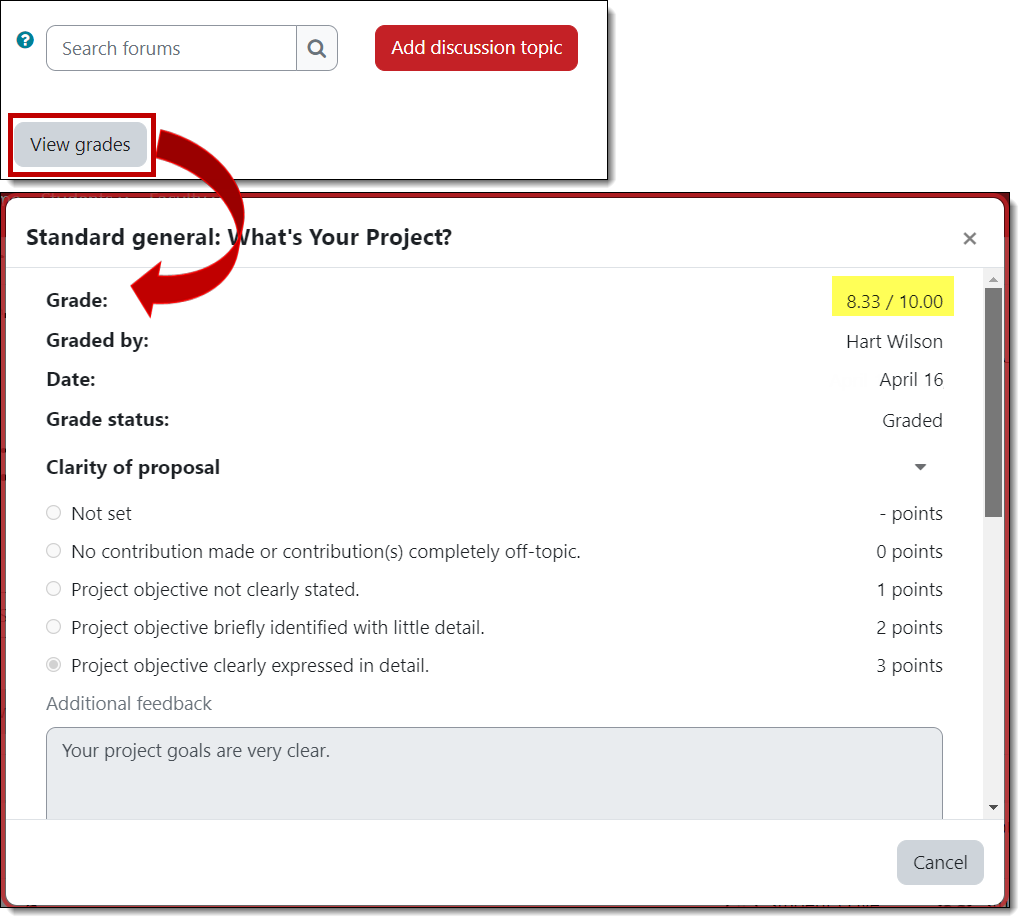
Announcements Forum
 The Announcements forum is used by instructors to communicate important information about the course. You will receive an email whenever your instructor posts to this forum. It's helpful to know that this is not a true forum—it's a form of one-way communication
for instructors to post announcements for course participants. You cannot reply to a posting here.
The Announcements forum is used by instructors to communicate important information about the course. You will receive an email whenever your instructor posts to this forum. It's helpful to know that this is not a true forum—it's a form of one-way communication
for instructors to post announcements for course participants. You cannot reply to a posting here.
Editing Text
Adding a Topic
When you add a discussion topic, you'll have a full editor in the textbox. You can write your response directly in the textbox provided or write it outside of Moodle and copy it over. If you draft your response outside of Moodle, copy what you have written using Ctrl+C or Cmd+C. Use Ctrl+V or Cmd+V to paste what you copied into the new text box (right-clicking and pasting will not work online due to browser limitations).
This complete guide to editing text describes the icons that you'll encounter in Moodle text boxes. Be sure to note the helpful hints provided along the way.
Replying to a Post
Unlike an initial post, the reply textbox features a simple interface for entering plain text: there are no editing tools immediately available to you. They are still there! You just have to click on the Advanced link in the lower right corner to access them.
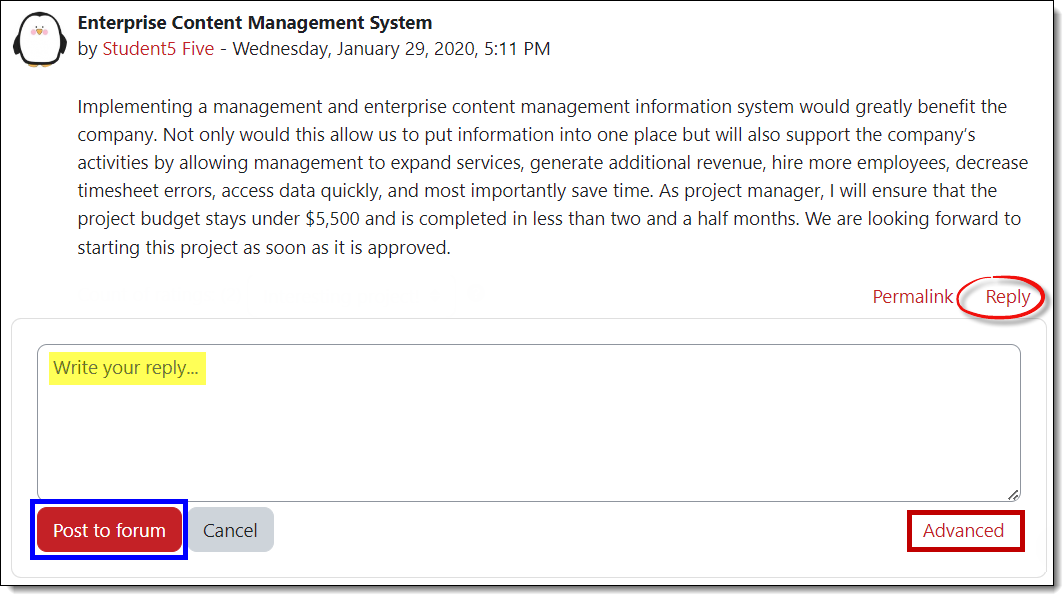
Once you open this editor, you'll be able to use all of the formatting options available in our normal HTML editor, as well as subscribe to a forum and/or attach a file.
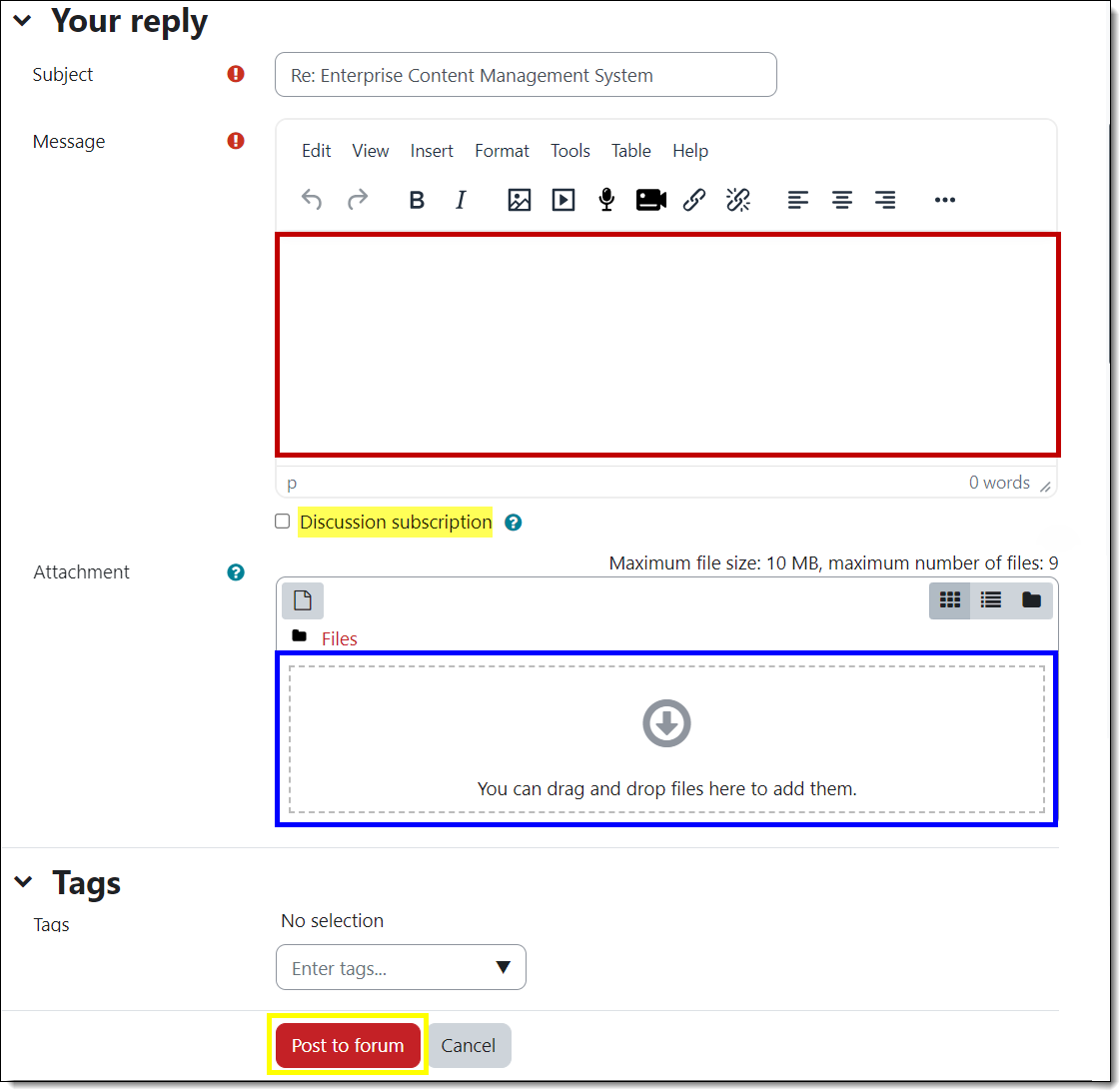
Attach a Link
 Would you like to insert a URL that others can click on to navigate to a website? Download these instructions to embed a link in any Moodle text box.
Would you like to insert a URL that others can click on to navigate to a website? Download these instructions to embed a link in any Moodle text box.
See this comprehensive guide to attach a file or display a video in a forum post.
Insert an Image
It's not hard to insert images in Moodle posts, but you do need to be careful about image size. Some important things to note about inserting images directly in Moodle textboxes such as forum posts, online text assignments, and glossaries:
- Images must be saved as individual files or posted to a website in order to be inserted in Moodle.
- Acceptable image file types are .jpg, .gif, and .png.
- You cannot copy and paste or drag and drop an image into Moodle. You must use the Insert/edit image icon on the toolbar. (See the illustrations here and/or the guide linked below to learn how to customize your image.)
- Images will display in their "native" (original) size, so be prepared to adjust them for best fit.
- When resizing images, you need only change one of the two dimensions as long as the "Auto size" option is checked. Moodle will adjust the other dimension to fit without stretching or flattening your image.
- If you have any trouble getting an image to appear where you want it to go with your text, try entering your text first, then inserting your cursor at the beginning of the paragraph where you want the image to be displayed and inserting the image at that point. Set the alignment for Right or Left and see what happens!
- Large image files (1 MB and up) are slow to load and take up valuable storage space. Learn about resizing images for Moodle or you can contact the Help Desk for assistance.
Read more about the entire inserting images in Moodle.
To insert an image:
- Click on the insert image icon in the textbox toolbar.
- Click on Browse repositories... to upload an image file from your computer or paste the URL of an image posted to the web in the field provided.
- After selecting your image, add a description of the image in the field provided to create "alt text" for anyone using an assistive device to view your posting or check the box below the description field to indicate that the image is purely decorative.
- Check the box to Auto size your image to ensure that the proportions are maintained correctly. (You can also designate a specific height or width for your image in pixels — 1 inch = 96 pixels [call it 100 and make it easy on yourself!].)
- Click on Save image to return to your textbox.
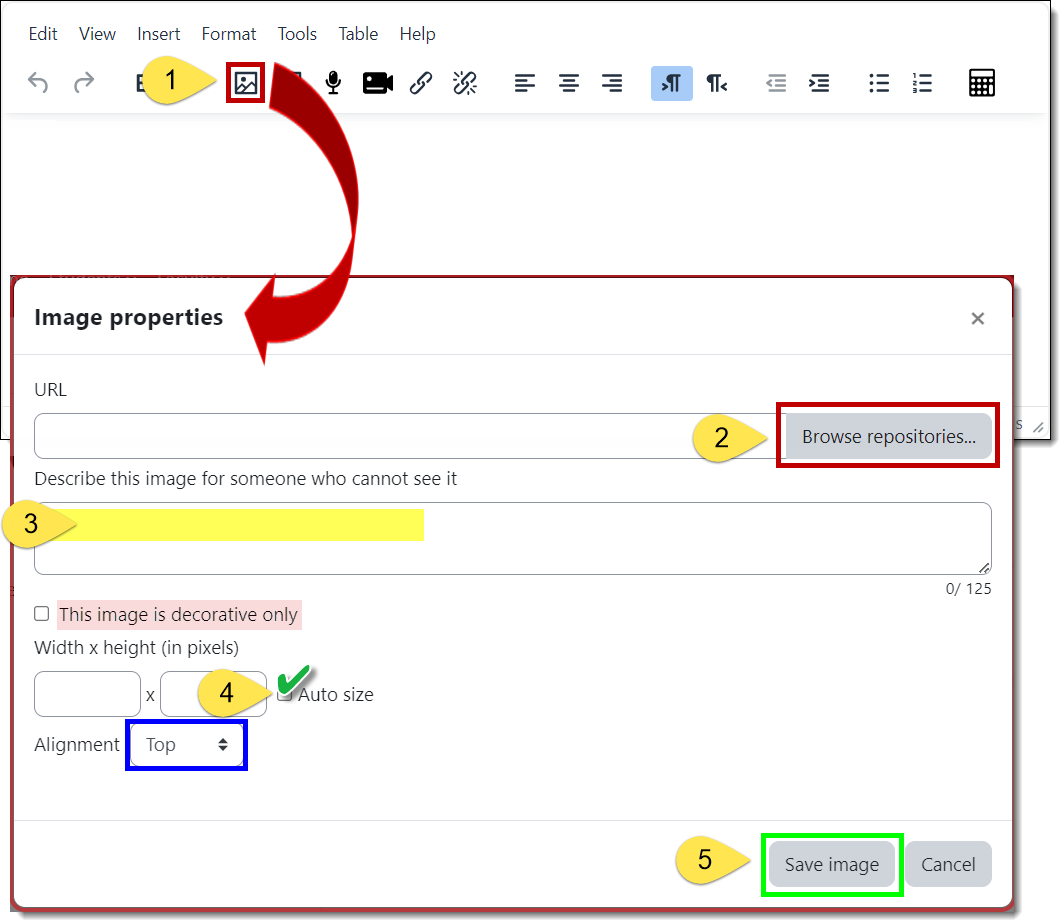
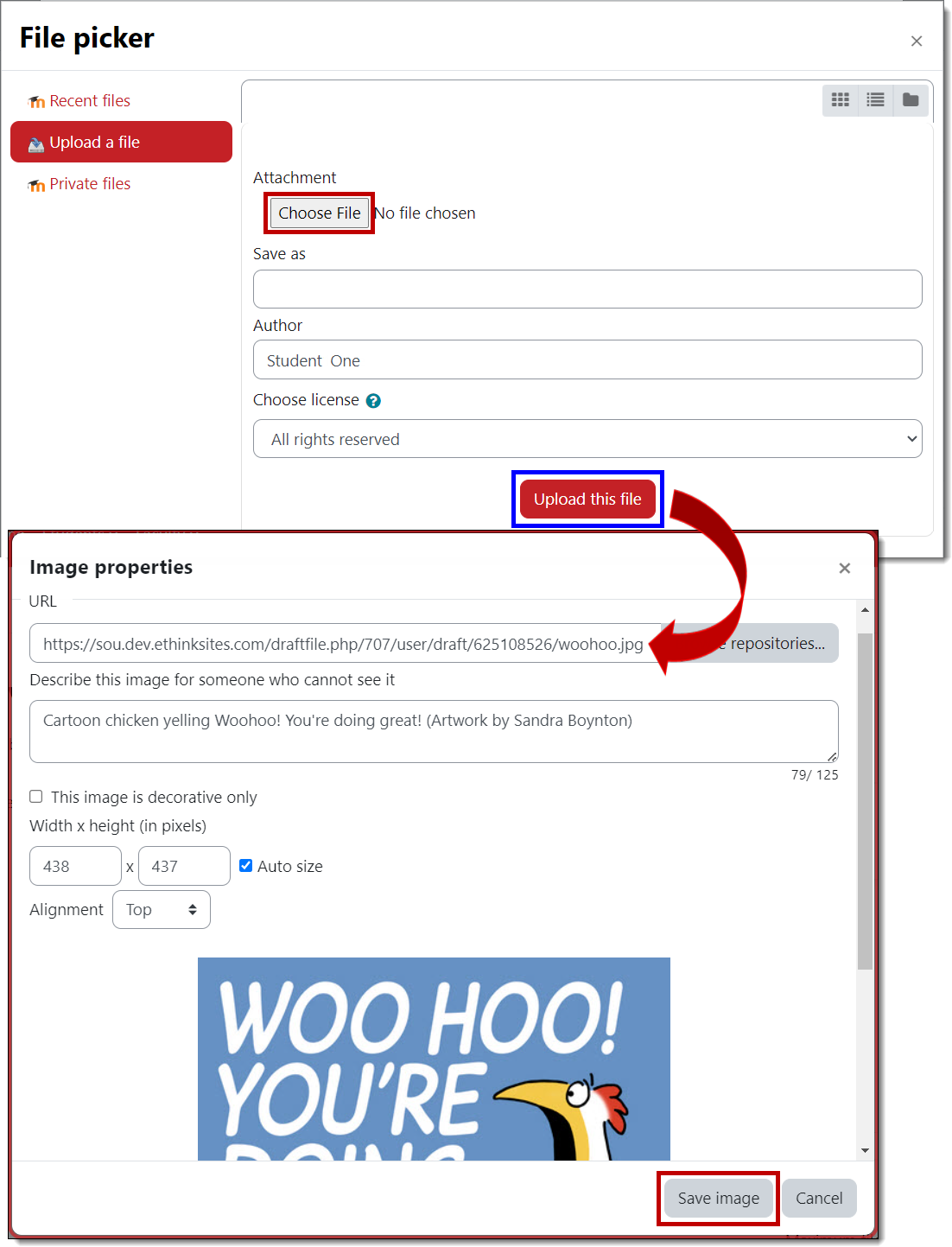
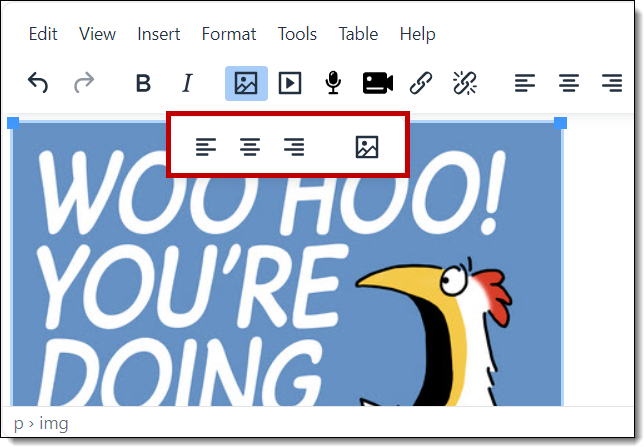
Subscribe to a Forum
 Moodle makes it possible to follow a forum or a discussion thread by "subscribing" to it. Each time a person posts to the forum (or replies to a post) that you're subscribed to, you'll receive an email message. This is really handy for group projects,
for instance, as you can be notified when one of your teammates has added a post.
Moodle makes it possible to follow a forum or a discussion thread by "subscribing" to it. Each time a person posts to the forum (or replies to a post) that you're subscribed to, you'll receive an email message. This is really handy for group projects,
for instance, as you can be notified when one of your teammates has added a post.
Some forums may be set up so that everyone is subscribed without having the option to unsubscribe. Ask your instructor if you have questions about a particular forum.
As shown in the first image below, you can subscribe to an entire forum by clicking on the Subscribe to forum button. The second image illustrates how you can subscribe to a specific discussion thread by clicking on the Subscribe icon in the forum. When you subscribe to a thread, you'll receive an email each time someone replies to that thread.
To unsubscribe from a forum, reopen the admin gear and click on Unsubscribe from this forum.

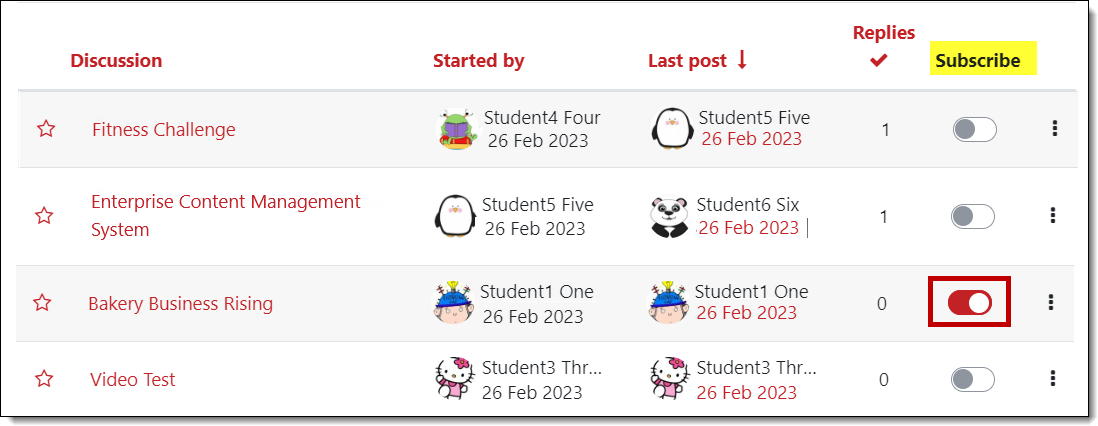
Update Your Preferences
In the early days of Moodle at SOU (prior to 2016), accounts were set up so that all users were automatically "subscribed" to discussion forums in their courses. As a result, once you had made a posting to a forum, you would receive an email message whenever anyone else made a post to that forum. That could be a lot of email! If your account was created prior to 2016 and you do not wish to receive these emails, you can turn off this feature by changing your forum preferences.
To disable this setting (and stop future automatic subscriptions):
- Open the user menu in the top right corner of your Moodle page.
- Click on Preferences, then Forum preferences.
- Use the pull-down menu to change the Forum auto-subscribe setting to No: don't automatically subscribe me to forums.
- For your convenience, update the Forum tracking setting to Yes: highlight new posts for me. This setting indicates when new messages have been posted by your instructor and classmates.
- Save changes.
Your auto-subscribe setting will apply to future forums in which you post in all of your course sites. If you are currently subscribed to a forum, you must unsubscribe yourself as shown on the previous page.
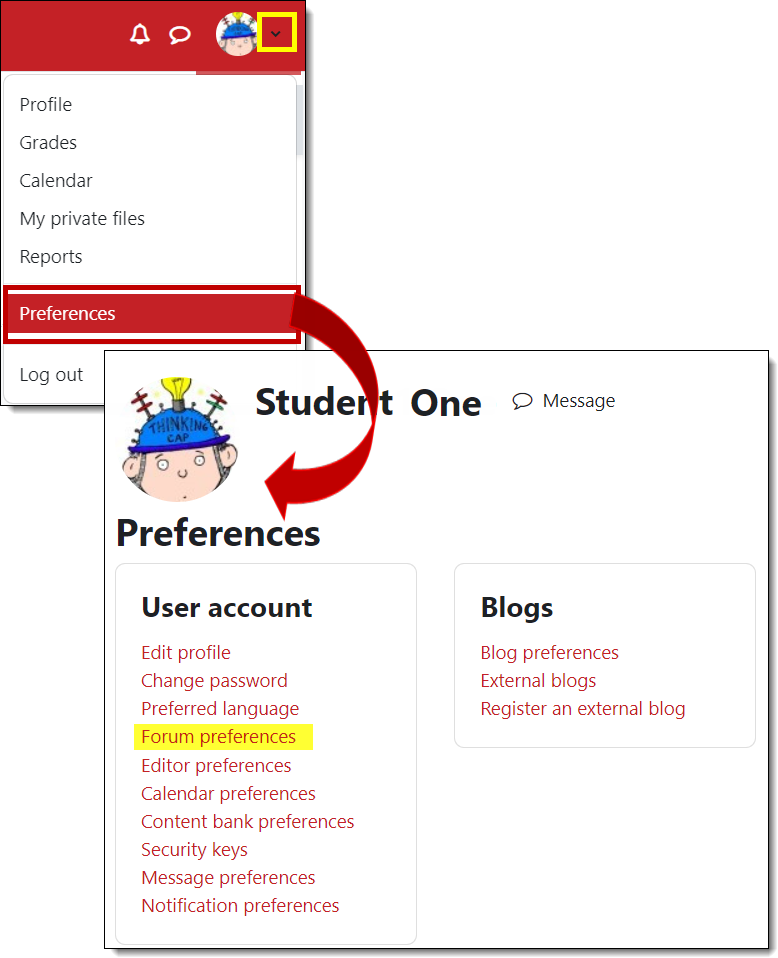
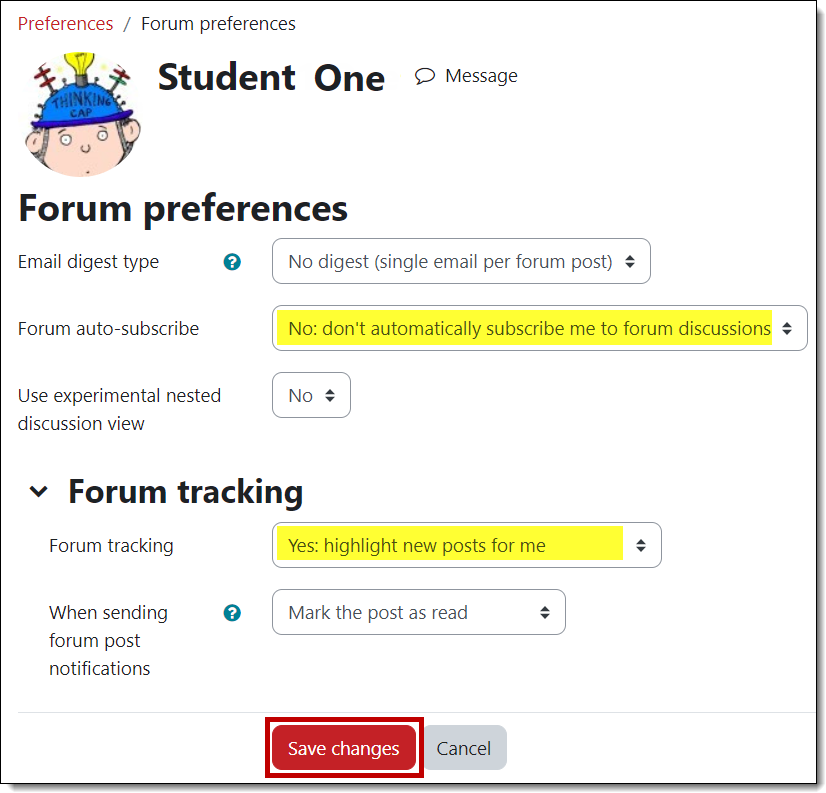
Working in Groups
 From time to time, your instructors may ask you to work on group projects in Moodle. Group work is conducted in specially designated discussion forums and in chat sessions reserved for groups. In both cases, Moodle offers two settings for group activities,
visible groups and separate groups:
From time to time, your instructors may ask you to work on group projects in Moodle. Group work is conducted in specially designated discussion forums and in chat sessions reserved for groups. In both cases, Moodle offers two settings for group activities,
visible groups and separate groups:
- Visible Groups: Everyone can see the work done by every group, but may only contribute in their assigned group.
- Separate Groups: Only group members (and the instructor) may contribute and view the group's work.
Working in Your Group Forum
In your designated group forum, click on the Add a new discussion link to post a message to your teammates. You can also use the Reply button to respond to a post made by one of your teammates.
Sharing Files
To share files with your group members, open the forum designated for your group work. Use the Add a new discussion link to post a message and attach your file(s). (If you need to attach multiple files and the forum is set up to accept only a single file, ask your instructor to adjust the forum settings—it's easily overlooked in the forum creation process.)Who's in my Group?
Moodle is a bit secretive about informing you of who else is in your group. One way to find out is to click on Compose new email in the Quickmail block in your course site. Click on the name of your group under Potential sections and
click on Add. You can also ask your instructor to add a "Group Members" resource to your course.
Working with Assignments
Moodle features three different types of assignment links:
- File uploads—submit one or more files
- Online text—enter text in a textbox
- Offline activity—perform a task that doesn't result in a digital artifact
You'll recognize an assignment by the submission icon that accompanies it on your course home page.
Download this guide to assignments for details. Refer to these detailed instructions on submitting a Turnitin assignment, including viewing an "Originality Report." See this comprehensive guide to attach a file or display a video in an online text assignment activity.
For more information and the opportunity to practice submitting an assignment, see the Assignments module in the Test Drive site. (You'll need to enroll in the course.)
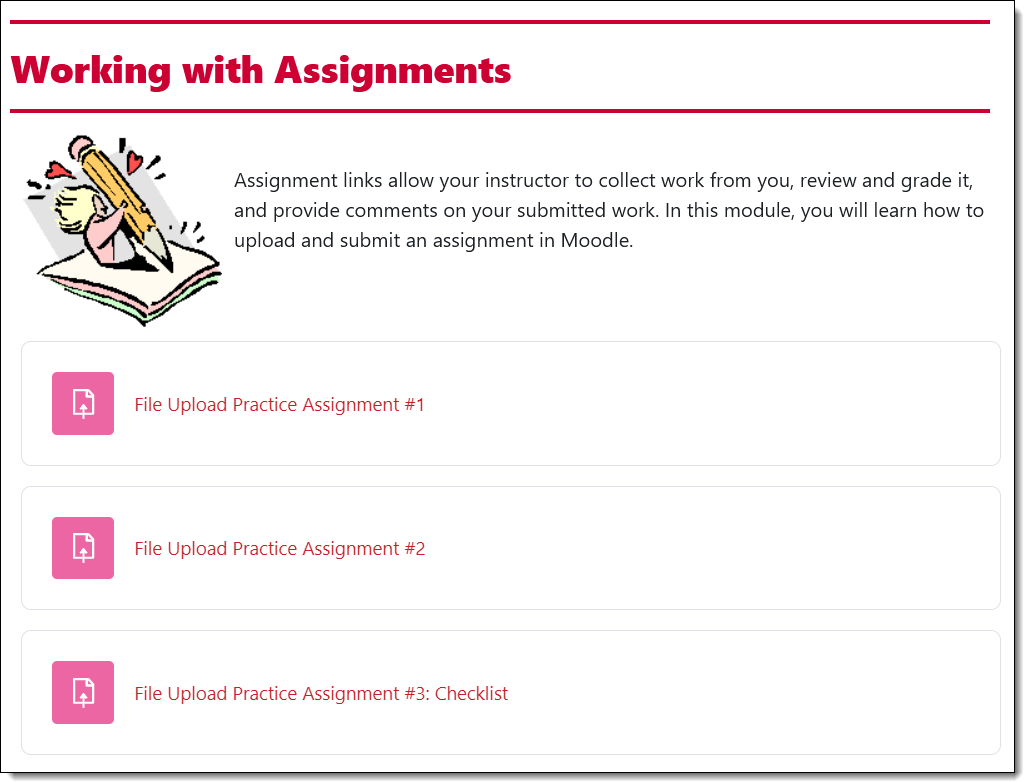
View Feedback
Looking at your score in the gradebook may only give you a glimpse of the feedback that your instructor has provided. To get the whole story, open the assignment link itself—that's where you can access a file that's been returned to you and/or review all of the elements that were scored in a rubric.
To see all of your instructor's feedback on your submission, open the assignment link and scroll down below the submission status section. You'll see any comments that your instructor has provided as well as any files returned to you. (See this article to learn about viewing feedback in a rubric.)
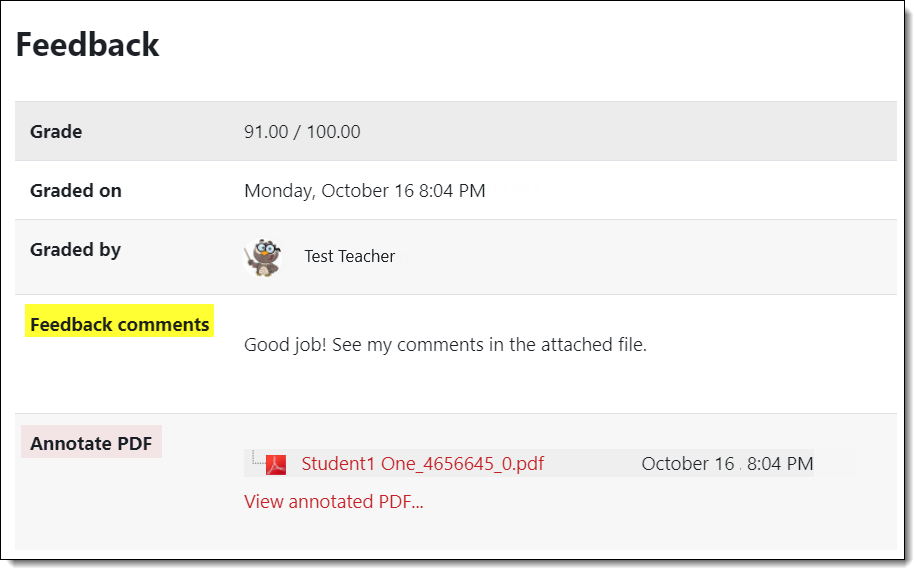
Upload Multiple Files
 You may find that you need to upload a folder with multiple files to an assignment link for a term project. To do so, you will need to compress your folder and create a .zip archive file. Once you have created your compressed file, open the assignment
link in Moodle and use the Add submission button to locate and upload your .zip file. Click on Save changes to submit.
You may find that you need to upload a folder with multiple files to an assignment link for a term project. To do so, you will need to compress your folder and create a .zip archive file. Once you have created your compressed file, open the assignment
link in Moodle and use the Add submission button to locate and upload your .zip file. Click on Save changes to submit.
Compress Files on a PC
- View Files. Open Windows Explorer and locate the files that you plan to submit.
- Verify Files Names. Review the names of the files you intend to submit. If any files contain # signs or other symbols, rename them to delete the symbols from the file names.
- Prepare Folder. Create a folder with an appropriate name to hold the desired files and move (or copy) all of the assignment files into the folder.
- Compress Folder. Right-click on the folder and choose Send to… then choose Compressed (zipped) folder.
The zip archive will appear in the same location. It will have the same name as the original folder, but it will be displayed with a zipper icon. If your folder view is set to display file types, the file name will include a ".zip" extension. Check the size of the zipped file to make sure it is less than 50 MB.
Compress Files on a Mac
- View Files. Open Finder and locate the files that you plan to submit.
- Verify Files Names. Review the names of the files you intend to submit. If any files contain # signs or other symbols, rename them to delete the symbols from the file names.
- Add file extensions (if necessary). If the file extension (e.g., .doc for a Word document, .ppt for a PowerPoint presentation, etc.) is missing from any of your file names, rename the file to add the correct file extension. Otherwise, your instructor might not be able to open the file. (To prevent this problem in the future, check the "Append file extension" box in the "Save As" screen in Word, PowerPoint, etc.)
- Prepare Folder. Create a folder with an appropriate name to hold the desired files and move (or copy) all of the assignment files into the folder.
- Compress Folder. Ctrl+click (or right click) on the folder and choose Compress.
The zip archive will appear in the same location. It will have the same name as the folder, but will be displayed with a ".zip" extension and a zipper icon. Check the size of the zipped file to make sure it is less than 50 MB.
Add Files to a Folder
 To make it easy for you to share your work with other students, your instructor may give you permission to upload files to a folder in your course site. These instructions explain how to upload and download files from a "student folder."
To make it easy for you to share your work with other students, your instructor may give you permission to upload files to a folder in your course site. These instructions explain how to upload and download files from a "student folder."
Reminder Notices
 You may receive reminder notices for assignments that are due (or overdue!). They come from an app designed to help you keep track of upcoming due dates.
You may receive reminder notices for assignments that are due (or overdue!). They come from an app designed to help you keep track of upcoming due dates.
If you would like to receive these reminder notices, you'll need to update your notification preferences—it just takes a moment!
You may receive a notice that an assignment you have completed is overdue—not to panic! The reminder is tied to the completion box for the assignment, not to your actual submission. You can read about how it works in this article.
Turnitin
 Turnitin is a service that reviews student papers, compares them against documents in its database (which includes websites, journals, papers submitted by students across the country, etc.), and generates a report indicating how much of the paper matches text from these sources.
Turnitin is a service that reviews student papers, compares them against documents in its database (which includes websites, journals, papers submitted by students across the country, etc.), and generates a report indicating how much of the paper matches text from these sources.
When you submit an assignment to Turnitin the first time, you will be asked to authorize an End User License Agreement (EULA). You can review those terms and conditions prior to agreeing to them. Regardless of whether you accept or decline the EULA or choose not to respond either way, it is possible for you to make a submission. If you decline to accept or skip the choice, your submission will not be submitted for review by Turnitin. According to US Department of Education rules, instructors have the right to require students to submit their work to an originality verification tool such as Turnitin. Thus, submission to Turnitin may be necessary in order to receive credit for an assignment, at your instructor’s sole discretion.
Learn more about submitting an assignment or forum post to Turnitin.
Basic Software Requirements
Our Platform: MS Office
SOU's official suite of desktop applications is Microsoft Office (Word, Excel, PowerPoint, etc.). Here are some tips and tools for using Office programs in Moodle:- Consider drafting long discussion forum responses in Word rather than in Moodle. If your Internet connection times out while you are reflecting and writing, you can lose your work.
- When you draft forum or other text responses in Word, you may see the best results for copying and pasting into Moodle if you use the clear formatting icon in the textbox toolbar. Using this tool will reduce formatting problems in Moodle text boxes. Select the text you have pasted into the textbox, then click on the Format link in the toolbar and select Clear formatting to remove the messy code that comes over from Word or Google.

Don't Have MS Office?
How to Obtain MS Office
If you do not have MS Office installed on your computer, you have options:
- Take advantage of web-based versions of MS Office compatible applications in Google Docs (overview of Google Docs).
- Log into Inside SOU, then open Office 365 from the Online Services block to download the latest version of Office or work in the application you need in the Cloud.
- Enter your SOU email address and click Sign in as shown below to open Office 365.
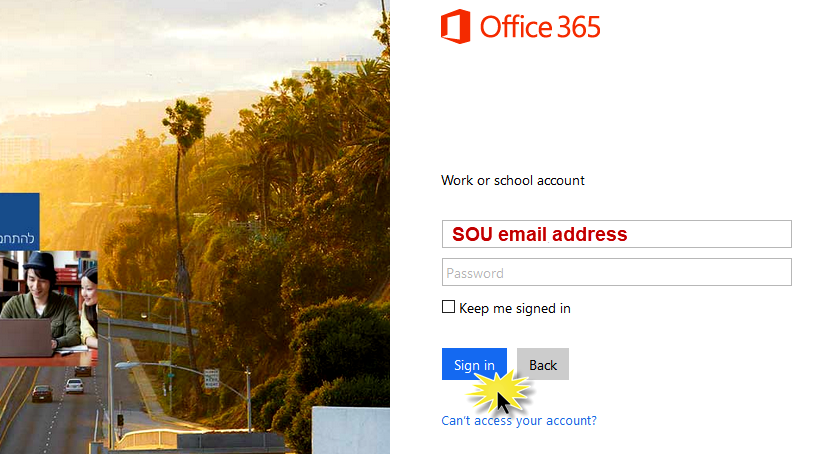
- Download Office or select the application you want to use and open it. You'll be able to save your files in a folder at Office 365 if you work in the Cloud.
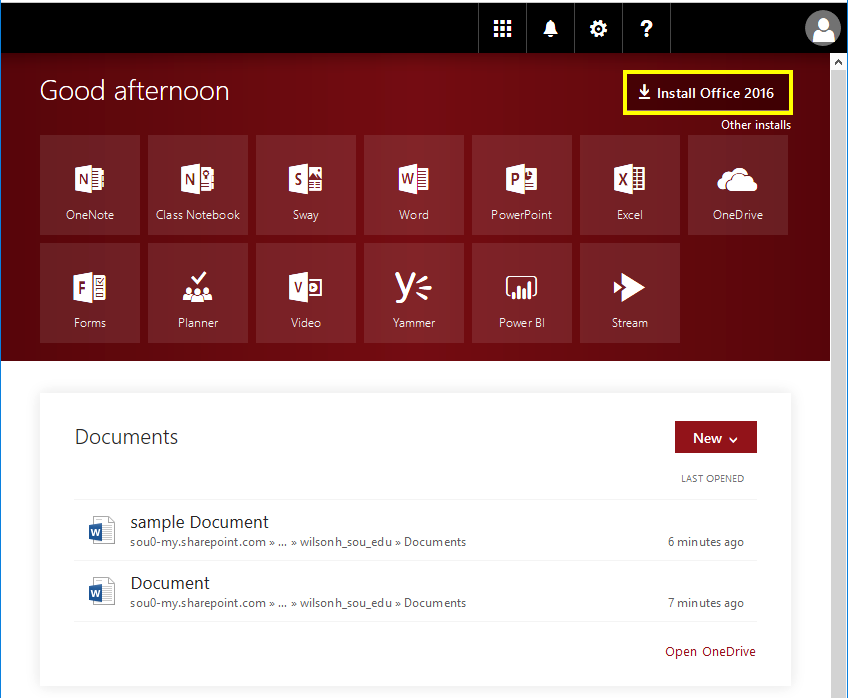
Other Applications
Other Software
Do you have all of these utility applications installed on your computer? Click on a logo to download the latest version. (See important note below before you start.)
for viewing pdf files
for playing audioand video files
 Please note: Some free programs may include optional software or email sign-ups for news and updates. You do not have to sign up for or install the optional (EXTRA) stuff. It is advisable NOT to check the optional boxes. Your free downloads will work just fine without the optional features.
Please note: Some free programs may include optional software or email sign-ups for news and updates. You do not have to sign up for or install the optional (EXTRA) stuff. It is advisable NOT to check the optional boxes. Your free downloads will work just fine without the optional features.
Taking Tests
 You will likely take quizzes and tests in Moodle while you are studying at SOU. These tips for taking tests include good information that you'll need to know to get started.
You will likely take quizzes and tests in Moodle while you are studying at SOU. These tips for taking tests include good information that you'll need to know to get started.
When you open a quiz attempt, you'll find a screen that looks similar to this:
Navigation links in the upper right corner show you where you are in the quiz and allow you to move back and forth between questions. Click on a question number to return to it.
If the quiz is timed, you'll see a clock that displays the time remaining.
Of course, you'll find test questions and possible answers. You'll see the points possible for each question. Note that you can "flag" a question if you wish to return to it.
Click on the Next button to move to the next page of questions. Your answers are automatically saved when you move to a new page. When you have finished answering questions, click on Finish attempt, then confirm that you are ready to submit your responses.
For more information about tests in Moodle, check out the related module in the Test Drive course.
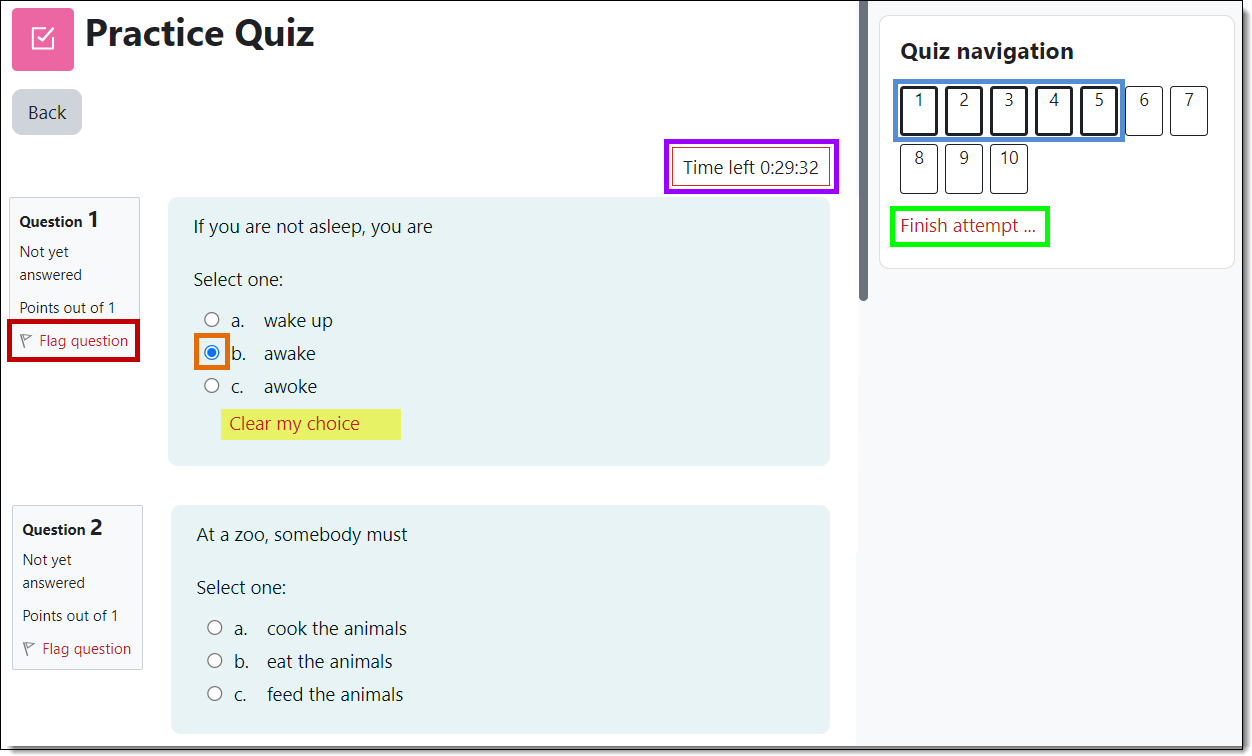
Review Quiz
In some cases, you can review your quiz results immediately after you submit a quiz. Other times, you may just see your grade at first, but after the quiz deadline you can review the results. Check with your instructor if you have any questions about reviewing a quiz.
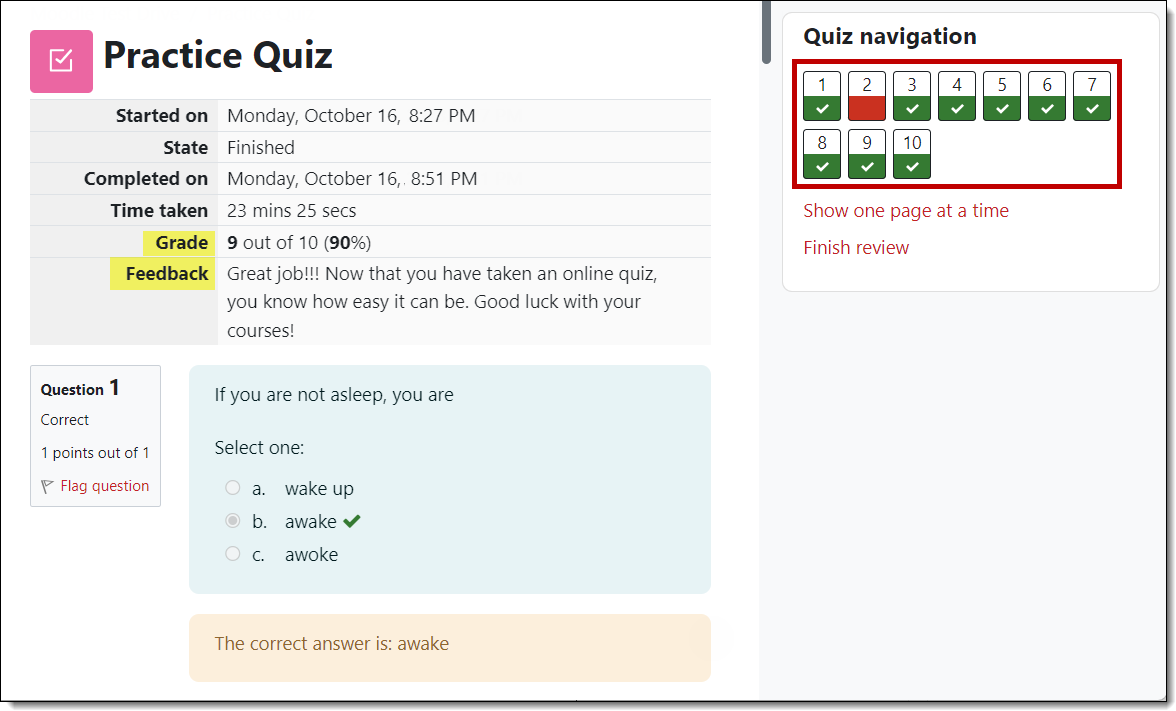
Checking Your Grades

Many instructors use Moodle's gradebook feature, but not all of them do so. Some instructors "weight" their grades, while others add up all of the scores and compute your grade based on the percentage of the total possible points you earn. While the gradebook
is useful for seeing how you are doing in a course, keep in mind that it is not the official record for your final grade.
Two things to keep in mind:
- Not all grades may be reflected in the grade book. Some instructors use complex grading formulae that don't lend themselves to Moodle's gradebook. Be sure to ask your instructor any questions you have about the gradebook.
- Your total points possible may not match someone else's. In most cases, the total points possible in your gradebook will reflect only the items graded so far. Thus, if your instructor has entered a grade for the paper you turned in on time, but has not yet graded your friend's late paper, your total possible score will differ from your friend's.
To check your grades, click on the Grades link at the top of your course page.
For more details about checking your grades, see the related book posted in the Test Drive site.

Rubrics & Checklists
An instructor may choose to assess your work using a rubric or checklist. Read about Advanced Scoring Guide before and after your work is graded.

Using Checklists
One feature that you may encounter is a checklist item that will list things you need to do for class. When you open a checklist, you'll see a list of things to accomplish for this section of the course, instructions about due dates or assignments, and your progress so far. Note that each item provides a direct link to that activity.

Autocheck vs. Auto/Self Check
The checklist above is set up so that the boxes will automatically be checked off as you complete the activities posted in the section. Items will be marked as complete as they get checked off on your main course page. You can tell that autocheck is in place because the check boxes are grayed out. In some cases, you will also be able to check things off yourself. The check boxes in that case will be white.
Using the Calendar
 Classes, homework, exams, papers, quizzes, parties, concerts, movies... The list goes on and on. You have so much to do, and it can be difficult keeping up with it all. How do you do it? One solution is to use your Moodle Calendar. The calendar can
become a great planning tool for your school and personal life. On your Moodle Calendar, you will see different types of events, assignment due dates, and course or school reminders.
Classes, homework, exams, papers, quizzes, parties, concerts, movies... The list goes on and on. You have so much to do, and it can be difficult keeping up with it all. How do you do it? One solution is to use your Moodle Calendar. The calendar can
become a great planning tool for your school and personal life. On your Moodle Calendar, you will see different types of events, assignment due dates, and course or school reminders.
The Moodle Calendar can be accessed from your Moodle home page and may be found in the blocks panel on the right side of your dashboard and your course pages. Expand the blocks panel to display the calendar.
Click on any date where an activity is linked — indicated in red with a dot below it — to display information about the activity and a link to it. Click on the link to learn more about the activity. To
add events of your own to the course events already listed, click on Full calendar.
Messages in Moodle
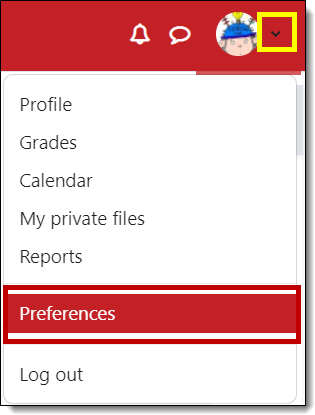 Choose when you'd like to receive messages from Moodle!
Choose when you'd like to receive messages from Moodle!
To customize your settings, click on the user menu next to your name in the upper right corner of your screen and choose Preferences.
From the list of options displayed, click on Notification preferences.
Email messages and pop-up notices will be sent to you according to the options that are checked in the notification configuration page shown below. You can choose notifications to be made when you are online—logged into Moodle—or offline—not logged into Moodle. To change these settings, click the boxes in the configuration table. The default settings will suit most students.
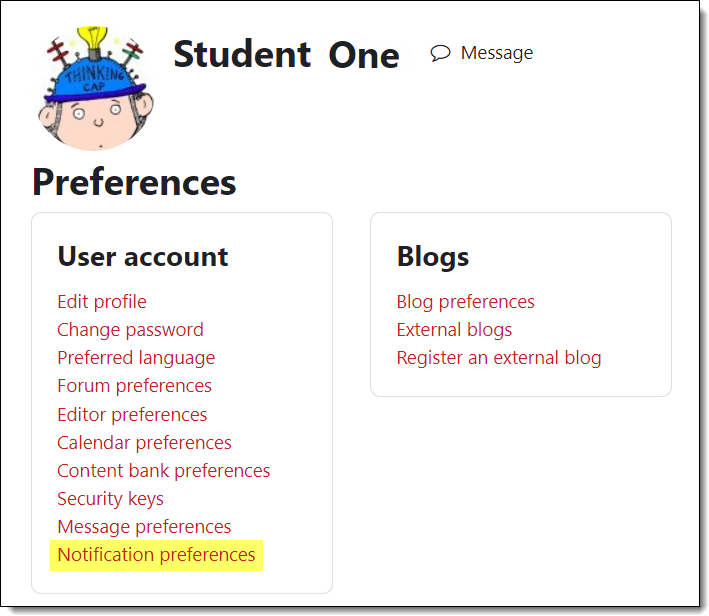
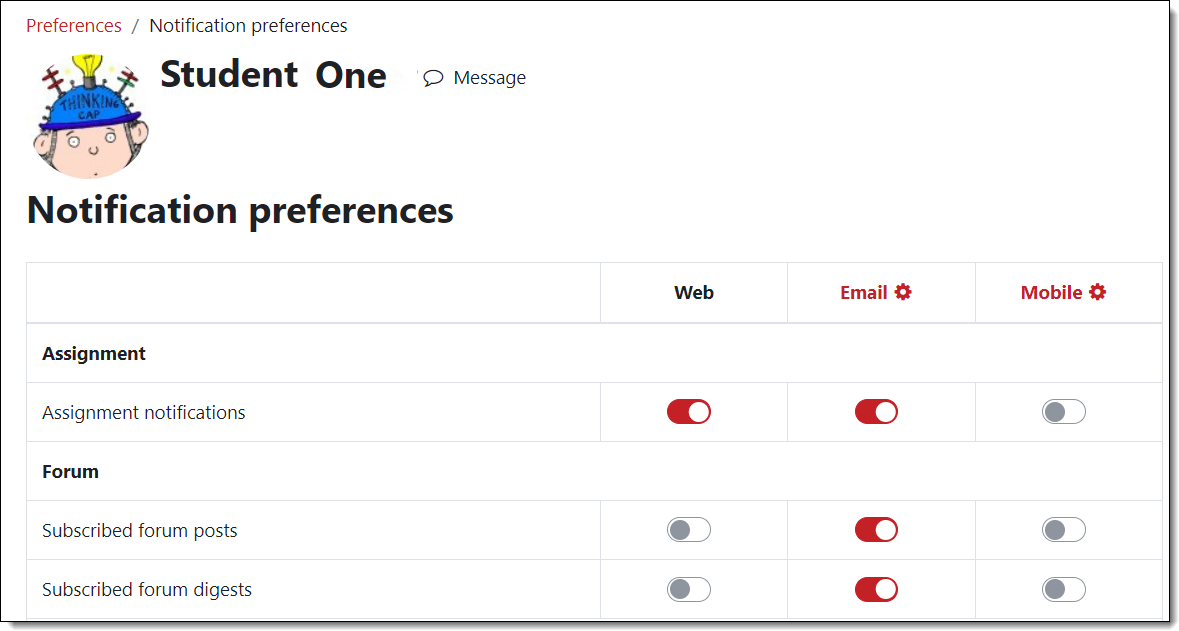
Finding SOU Services
These links will connect you to a wide range of student services at SOU. (All links open in new window.)
🆘 Getting Help 🆘

Explore Online Resources
- Visit Moodle How-tos for quick answers to frequently asked questions and documentation for students.
- Check out these Online Learning at SOU.
- Try out Moodle functions—enroll yourself in the Test Drive course. Learn about special Moodle activities and try them out (there will be a quiz, but it's just for fun!). Activities you can try out:
- Forums
- Assignments
- Quizzes
- Questionnaires
- Choices
- Glossaries
- Wikis
- Boards
- Hypothes.is annotations
Ask for Help
Help is available! To help us help you faster and better:
- Let us know what course you're asking about—the CRN is displayed in the "breadcrumb" trail at the top of each page.
- Be as clear as possible about the problem you are having—let us know the name of the activity or resource that is not working for you. For even faster help, open the item and copy the URL to include with your message. Screenshots are also helpful!
- Check your email frequently in case we have follow-up questions or recommendations for you.
- Let us know when your problem is resolved.
Here's how to reach the Moodle Help Desk:
- Call the Help Desk at 541-552-6900.
- Email the Help Desk at HelpDesk@sou.edu.
- Go to https://support.sou.edu, log in and create a "ticket" to post your question—select Moodle as the department to expedite your ticket (we're often online after the Help Desk is closed!).
